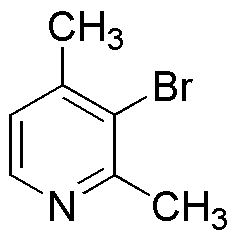3-Bromo-2,4-dimethylpyridine is widely utilized in research focused on:
- Synthesis of Pharmaceuticals: This compound serves as a key intermediate in the synthesis of various pharmaceuticals, particularly those targeting neurological disorders, enhancing drug efficacy and specificity.
- Agricultural Chemicals: It is used in the development of agrochemicals, including herbicides and fungicides, providing effective solutions for crop protection while minimizing environmental impact.
- Organic Synthesis: As a versatile building block, it plays a crucial role in organic synthesis, facilitating the creation of complex molecules in the chemical industry.
- Research in Material Science: The compound is explored in the development of new materials, including polymers and coatings, due to its unique chemical properties that enhance material performance.
- Catalyst Development: It is investigated for its potential as a catalyst in various chemical reactions, improving reaction rates and selectivity compared to traditional catalysts.
General Information
Properties
Safety and Regulations
Applications
3-Bromo-2,4-dimethylpyridine is widely utilized in research focused on:
- Synthesis of Pharmaceuticals: This compound serves as a key intermediate in the synthesis of various pharmaceuticals, particularly those targeting neurological disorders, enhancing drug efficacy and specificity.
- Agricultural Chemicals: It is used in the development of agrochemicals, including herbicides and fungicides, providing effective solutions for crop protection while minimizing environmental impact.
- Organic Synthesis: As a versatile building block, it plays a crucial role in organic synthesis, facilitating the creation of complex molecules in the chemical industry.
- Research in Material Science: The compound is explored in the development of new materials, including polymers and coatings, due to its unique chemical properties that enhance material performance.
- Catalyst Development: It is investigated for its potential as a catalyst in various chemical reactions, improving reaction rates and selectivity compared to traditional catalysts.
Documents
Safety Data Sheets (SDS)
The SDS provides comprehensive safety information on handling, storage, and disposal of the product.
Product Specification (PS)
The PS provides a comprehensive breakdown of the product’s properties, including chemical composition, physical state, purity, and storage requirements. It also details acceptable quality ranges and the product's intended applications.
Certificates of Analysis (COA)
Search for Certificates of Analysis (COA) by entering the products Lot Number. Lot and Batch Numbers can be found on a product’s label following the words ‘Lot’ or ‘Batch’.
*Catalog Number
*Lot Number
Certificates Of Origin (COO)
This COO confirms the country where the product was manufactured, and also details the materials and components used in it and whether it is derived from natural, synthetic, or other specific sources. This certificate may be required for customs, trade, and regulatory compliance.
*Catalog Number
*Lot Number
Safety Data Sheets (SDS)
The SDS provides comprehensive safety information on handling, storage, and disposal of the product.
DownloadProduct Specification (PS)
The PS provides a comprehensive breakdown of the product’s properties, including chemical composition, physical state, purity, and storage requirements. It also details acceptable quality ranges and the product's intended applications.
DownloadCertificates of Analysis (COA)
Search for Certificates of Analysis (COA) by entering the products Lot Number. Lot and Batch Numbers can be found on a product’s label following the words ‘Lot’ or ‘Batch’.
*Catalog Number
*Lot Number
Certificates Of Origin (COO)
This COO confirms the country where the product was manufactured, and also details the materials and components used in it and whether it is derived from natural, synthetic, or other specific sources. This certificate may be required for customs, trade, and regulatory compliance.


